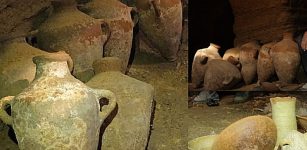Cycladic Figurines Of Ancient Crete – International Symposium With Scholars From Around The World
AncientPages.com - The International Symposium “Cycladica in Crete: Cycladic and Cycladicizing figurines within their archaeological context” will take place on Thursday 1st and Friday 2nd October 2015 at the Museum of Cycladic Art in Athens.
The purpose of the Symposium on the Cycladic and Cycladic-type figurines from Crete is to illuminate the sort of relations between the Cyclades and Crete during the 3rd millennium BC in light of modern research through the discussion of all the relevant finds that have from time to time been made in Crete.
There are 23 papers on the topic to be given in the Symposium by well-known scholars from Greece, Britain, Germany, Belgium and the United States of America.
Sophisticated knowledge and techniques for shipbuilding and navigation made it possible for this civilization to explore the Aegean Sea and to extend its trade to other Hellenic areas, even as far away as Asia Minor.
The Cycladic culture, one of the most important cultures of the prehistoric Aegean, flourished in the 3rd millennium BC. During that period the islands of the Cyclades had a leading role in the transit trade in the Aegean, thus acting as intermediaries in the movement of raw materials, ideas and products of technology originating from areas both within and beyond the Aegean (such as inland Asia Minor and the Black Sea) from one end of the archipelago to the other.
Image credit: Museum of Cycladic Art
The first Aegean civilization, the Cycladic Civilization was developed between 3200 and 2000 BC in a small group of Aegean islands that took the name Cyclades, from the Greek "cyclos" (circle) because the islands form a circle around Delos, regarded as the jewel in the crown of the archipelago. Archaeological excavations revealed that the inhabitants of the Cycladic Civilization lived in square stone houses close to the coast. Agriculture, farming and fishing were the primary activities of residents.
In the period of the floruit of the Cycladic culture, around the middle of the 3rd millennium BC, the influence exerted by the Cyclades on other Aegean areas is intense. Cycladic products, including both raw materials and finished objects of Cycladic provenance or inspiration, are widely circulated in the Aegean.
Marble Cycladic figurines were so great that they are not only imported but also appear to be copied in areas beyond the Cyclades, particularly in Crete, which has produced the largest number of Cycladic and Cycladic-type figurines from all the other areas of the Aegean: about 90 such figurines have been found so far in excavations in Crete, sometimes in contexts providing information about the “archaeology” of ancient times.
This taken together with the fact that these figurines are often found smashed in the way they are in the Cycladic islands suggests that they were not simply imported or copied as objects of prestige and social differentiation but also conveyed the symbolic meaning they had been assigned in the Cyclades.
AncientPages.com






















